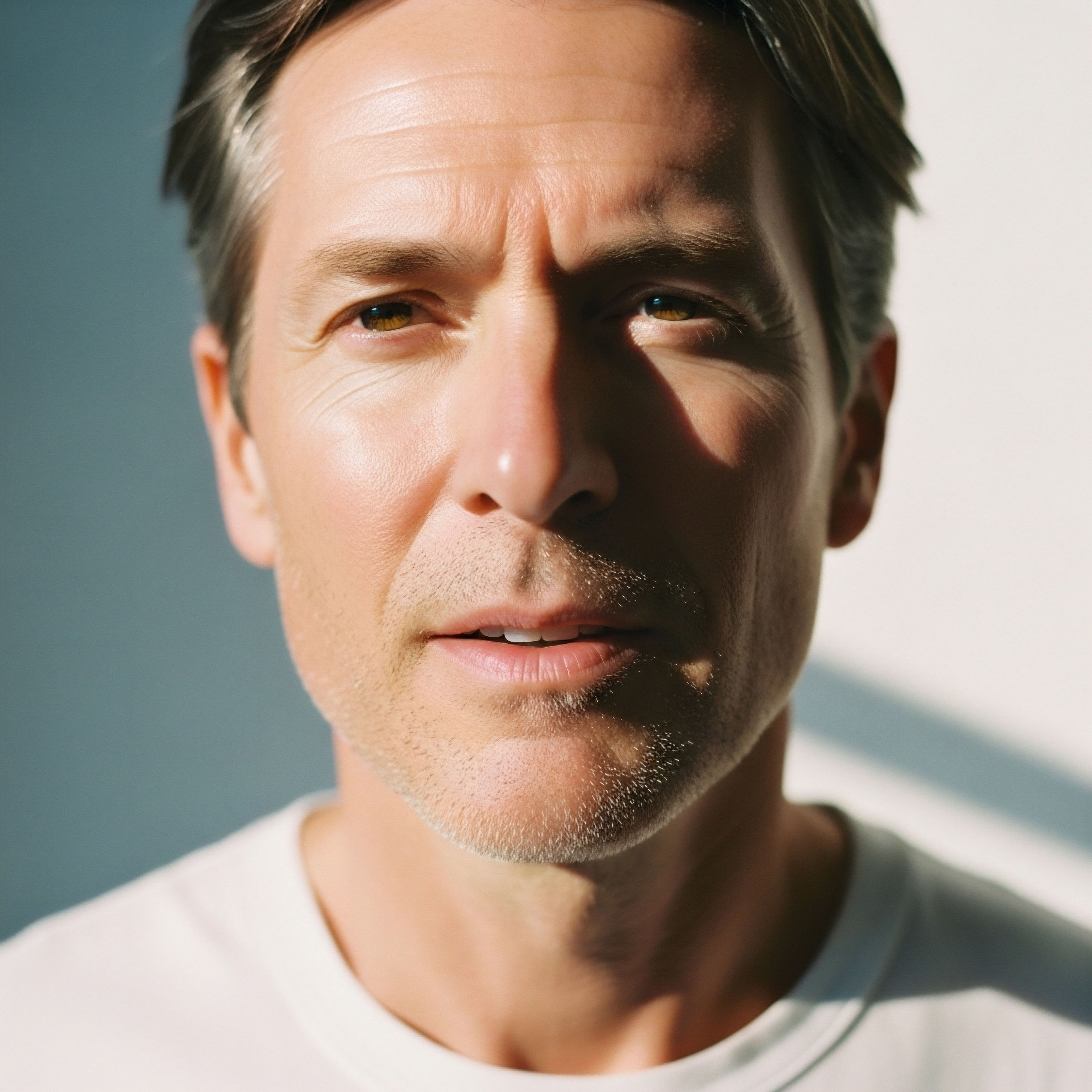

Why Your Body’s True Barometer Is Not on a Cuff
You have been taught to measure your life’s potential in millimeters of mercury. A number on a machine, a snapshot of pressure against an arterial wall, has been positioned as the definitive statement on your future. This is a profound limitation of an old paradigm. The architecture of a long, vibrant life is written in a language of force, efficiency, and cellular communication. Your true vital signs are not passive readings. They are active expressions of your biological power.
The conversation around health has for too long been centered on the management of decline. We track numbers that signal system failures. A different approach exists, one that focuses on building and quantifying capacity. This is the engineering of vitality.
It begins with the recognition that how you move, how you generate force, and how your body utilizes oxygen at a cellular level are the primary drivers of your healthspan. These are the metrics that define your ability to engage with the world with power and grace.
Physical strength, specifically the force you can generate with your hands, is a direct data point reflecting your body’s systemic integrity. A strong grip is an output of a healthy neuromuscular system and a proxy for your overall muscle quality and mass. Muscle is the organ of longevity.
Its capacity is directly tied to metabolic health, hormonal balance, and your resilience against physical stressors. Viewing strength as a vital sign recalibrates the entire wellness equation from one of absence of sickness to one of presence of power.
Similarly, your cardiovascular system’s true measure of performance is its peak efficiency. The metric of VO2 max, the maximum volume of oxygen your body can consume and use during intense exertion, is a far more revealing indicator of longevity than resting heart rate or blood pressure.
It is a statement of your metabolic engine’s horsepower. A high VO2 max signifies efficient mitochondria, the power plants within your cells, and reflects a body that can effectively produce energy to meet any demand. This is the physiology of endurance, of sustained performance in every aspect of life.
Grip strength has been identified in clinical studies as a stronger predictor of all-cause and cardiovascular mortality than systolic blood pressure.
The third pillar of this new vitality framework resides deep within your bloodstream, on a level far more specific than a standard cholesterol panel. The quantity of Apolipoprotein B (ApoB) particles reveals the true traffic density of potentially atherogenic lipoproteins in your system.
While LDL-C measures the amount of cholesterol cargo, ApoB counts the number of transport vehicles. A high particle count creates a higher probability of arterial wall infiltration, the foundational event in cardiovascular disease. Understanding this distinction is fundamental to a modern, precise approach to managing cardiovascular health and longevity.
Moving beyond blood pressure means shifting your perspective from a defensive crouch to a forward lean. It requires you to see your body as a high-performance system that can be measured, understood, and optimized. Your capacity for force production, your peak aerobic efficiency, and the precise composition of your lipid profile are the data streams that truly matter.
These are the vital signs that signal not just the absence of disease, but the presence of a robust, resilient, and thoroughly optimized human system ready for the demands of a long and ambitious life.


The Architecture of a Longer Life
Constructing a life of extended vitality requires a blueprint. This blueprint is built upon the deliberate enhancement of the body’s core performance metrics. The process is systematic, grounded in physiological principles, and available to anyone willing to engage with their biology on a more sophisticated level. We will architect this enhanced state by focusing on three foundational pillars ∞ recalibrating your systemic strength, upgrading your metabolic engine, and clarifying your cardiovascular risk.

Grip Strength the Index of Systemic Power
Your ability to exert maximal force through your hands is a direct window into your overall health. It is a biomarker for biological age and a powerful predictor of future health outcomes. A decline in grip strength is an early signal of sarcopenia, the age-associated loss of muscle mass, which is a primary driver of frailty and metabolic dysfunction.
A powerful grip, conversely, indicates robust neuromuscular function and a healthy reserve of lean tissue. Building it is a direct investment in your physical autonomy.
The protocol for enhancing this vital sign involves targeted training that challenges both the muscles of the hand and the larger systems that support them. This is about building raw, functional strength that translates into real-world capacity.
- Heavy Carries ∞ The farmer’s walk, where you carry a heavy weight in each hand for distance or time, is a foundational movement. It develops crushing grip strength, core stability, and overall fortitude. Aim for a weight that challenges you to maintain your grip for 30-60 seconds.
- Static Holds ∞ The dead hang from a pull-up bar is a simple yet profoundly effective exercise. The goal is to accumulate time under tension. Start with short hangs of 10-15 seconds, and progressively build towards a total of 2-3 minutes of accumulated hang time per session. This builds endurance in the flexor muscles of the forearm.
- Thick Grips ∞ Incorporating fat grips or axle bars into your regular lifting routine for exercises like rows and presses dramatically increases the demand on your grip. This forces greater muscle activation in the hands and forearms, accelerating strength gains.
- Direct Grip Work ∞ Using specialized grippers or stress balls with significant resistance can isolate the hand muscles for focused improvement. This is a supplemental tool to be used after your primary strength work is complete.
Measuring your progress is simple. A handheld dynamometer provides a precise reading in kilograms or pounds. Tracking this number every 4-6 weeks provides objective data on the efficacy of your protocol. The goal is to move into the upper quartiles for your age and sex, effectively engineering a younger biological age for yourself from a strength perspective. Improvements in grip strength often correlate with increases in total body strength and lean muscle mass.

VO2 Max Your Engine’s Oxygen Efficiency
Cardiovascular fitness, when viewed through a performance lens, is about one thing ∞ the ability of your body to take in oxygen from the air and deliver it to your muscles to generate energy. VO2 max is the ultimate measure of this capacity.
A high VO2 max is the signature of a powerful heart, efficient lungs, and mitochondria that are dense and highly functional. Research shows a direct, dose-dependent relationship between a higher VO2 max and a longer life, with significant reductions in all-cause mortality. Improving it is one of the most potent actions you can take for your longevity.
A study of over 122,000 adults found that individuals with the lowest level of cardiorespiratory fitness had a mortality rate nearly four times higher than those with the highest fitness levels.
The key to elevating your VO2 max is structured training that pushes your body to its aerobic limit. This forces the physiological adaptations that define a more efficient engine. The most effective method for this is a specific form of high-intensity interval training.
The 4×4 protocol is a well-researched and highly effective regimen:
- Warm-up ∞ Begin with 10-15 minutes of light aerobic activity to prepare your body for the work ahead.
- First Interval ∞ Perform 4 minutes of high-intensity exercise. This should be at an intensity where you are breathing heavily and can only speak one or two words at a time, roughly 85-95% of your maximum heart rate. The mode of exercise can be running, cycling, rowing, or any activity that allows you to sustain this effort level.
- Active Recovery ∞ Follow the high-intensity interval with 3-4 minutes of very low-intensity active recovery. This allows your heart rate to come down and prepares you for the next effort.
- Repeat ∞ Complete a total of four of these high-intensity intervals. The consistency of the effort across all four intervals is crucial.
- Cool-down ∞ Finish with 5-10 minutes of low-intensity activity.
Performing this protocol twice per week is a potent stimulus for your cardiorespiratory system. The intense efforts signal the body to build more capillaries, increase blood volume, and enhance mitochondrial function, all of which contribute to a higher VO2 max. This is a direct biological upgrade, enhancing your capacity for work and your resilience to disease.

Apolipoprotein B the True Traffic Count on Your Arterial Highways
The standard lipid panel, with its focus on LDL cholesterol (LDL-C), provides an incomplete picture of cardiovascular risk. LDL-C measures the total mass of cholesterol within LDL particles, akin to weighing all the cargo on a fleet of ships.
Apolipoprotein B (ApoB) provides a more critical piece of data ∞ it directly counts the number of ships in the water. Each potentially atherogenic particle, including VLDL and LDL, has one ApoB molecule attached to it. Therefore, your ApoB level is a direct measure of the concentration of these particles in your plasma.
Cardiovascular risk is driven by the number of these particles. A higher number of particles leads to a greater chance that some will penetrate the arterial wall, initiating the inflammatory cascade that results in plaque. Two individuals can have the same LDL-C level but vastly different ApoB counts, and therefore, vastly different levels of risk. The person with a higher ApoB has more, smaller, denser LDL particles, a condition that is highly atherogenic. Measuring ApoB removes this ambiguity.
Optimizing your ApoB level involves a multi-faceted approach focused on diet, exercise, and, when necessary, targeted therapeutics. The goal is to reduce the total number of atherogenic particles your liver produces.
Dietary modifications are foundational. Reducing the intake of saturated fats and refined carbohydrates can have a significant impact on liver fat and VLDL production, which in turn lowers the number of downstream LDL particles. Increasing dietary fiber, particularly soluble fiber from sources like oats, psyllium husk, and legumes, helps to bind cholesterol in the gut and remove it from the body.
Exercise contributes significantly. Both aerobic and resistance training improve insulin sensitivity, which helps regulate lipid metabolism. The improvements in VO2 max and muscle mass discussed earlier are not isolated; they directly support a healthier lipid profile.
For individuals with genetically high ApoB levels or those who do not respond sufficiently to lifestyle changes, modern medicine offers precise tools. A physician specializing in proactive health can guide the use of therapies designed to directly lower ApoB particle production or enhance their clearance from the circulation. This advanced, data-driven approach to cardiovascular health, centered on the most accurate risk biomarker, is a core component of the modern longevity toolkit.


Calibrating Your Timeline for Peak Performance
The optimization of your biology is not an event; it is a continuous process of measurement and refinement. The timeline for this process unfolds across different scales, from the immediate feedback of a single workout to the long-term trajectory of your healthspan. Understanding when to act and when to expect results is key to mastering this system.

The Initial Calibration Phase
The ideal time to establish your baseline for these true vital signs is now. Regardless of your current age or condition, gathering initial data on your grip strength, estimated VO2 max, and ApoB level provides the starting coordinates on your personal performance map.
This initial assessment, ideally conducted in your 30s or 40s, offers a powerful snapshot of your biological age before significant age-related decline typically begins. This is the moment you shift from passive aging to a program of active biological curation.
Initial changes in response to a new protocol can manifest quickly. Within the first two to four weeks of consistent strength training, you will notice neurological adaptations. Your brain becomes more efficient at recruiting muscle fibers, leading to rapid gains in strength and coordination. Your grip will feel stronger, and weights that once felt challenging will become more manageable. This is the nervous system learning to use the hardware it already has more effectively.

The Adaptation and Growth Phase
The timeline for tangible, structural changes in your body is measured in months. After six to eight weeks of dedicated training, you will begin to see measurable improvements in your VO2 max. Your body will have started building the physiological infrastructure for higher performance ∞ increased mitochondrial density and enhanced capillary networks.
You will notice this as a change in your endurance; your capacity for sustained effort will have tangibly increased. The 4×4 interval sessions will feel less daunting, and your recovery between intervals will be quicker.
Similarly, physical changes in muscle mass become more apparent after two to three months of consistent resistance training. This is when hypertrophy, the actual growth of muscle fibers, begins to compound. Your grip strength dynamometer readings will confirm this progress with objective data. Changes in your ApoB level in response to dietary and lifestyle adjustments typically become clear on a similar timescale, with blood tests at the three-month mark often showing a significant response.

The Long-Term Optimization Horizon
Viewing your health through the lens of these vital signs transforms your perspective on aging. The goal becomes to manage the rate of decline, to flatten the curve of age-related decay. Annual or biannual testing of your grip strength, VO2 max, and ApoB creates a long-term dataset of your vitality. You can see the effects of your protocols over years, making strategic adjustments to maintain your performance within an optimal range.
This long-term view is where true mastery is achieved. You learn to anticipate plateaus and adjust your training. You understand how periods of high stress or poor sleep are reflected in your numbers. Your health is no longer a mystery. It becomes a system you understand and direct.
The payoff is not just a number on a chart; it is the preservation of function, the extension of vitality, and the ability to operate at your peak capacity for the duration of your life.

Mastering the Chemistry of Your Own Performance
The information presented here is more than a guide; it is a declaration of agency. You possess the ability to architect a superior version of yourself by focusing on the metrics that define true functional capacity. The signals of your body’s strength, the efficiency of its engine, and the clarity of its internal pathways are the readouts that matter.
Engaging with this data is the first step in moving from being a passenger in your own biology to being the pilot. Your potential is not a fixed state. It is a dynamic system awaiting your command.

Glossary

healthspan

blood pressure

vo2 max

metabolic engine

apolipoprotein b

biological age

grip strength

neuromuscular function

muscle mass

your apob level

proactive health




